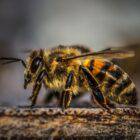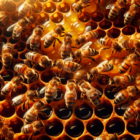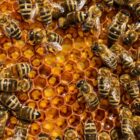Why Are Asian Hornets So Dangerous to Bees?
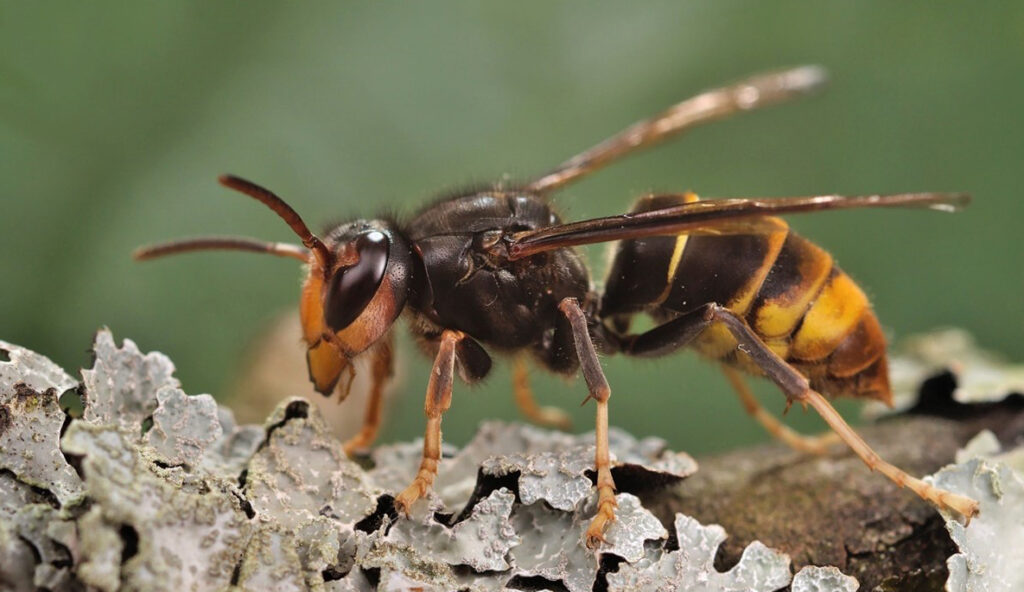
Asian hornets (Vespa velutina), also known as yellow-legged hornets, are a species of hornet native to Southeast Asia characterized by their distinctive yellow legs and dark abdomen, with a single yellow band near the posterior end. These hornets have gained significant attention due to their potential threat to bee populations, particularly in Europe where they have become an invasive species.
Meet The Asian Hornet
Compared to the European hornet, Vespa velutina is significantly smaller, with queens measuring approximately 30 mm (1.2 in) in length and males about 24 mm (0.95 in). Workers are even smaller, typically around 20 mm (0.80 in) long.
One of the most distinguishing features of Asian hornets is their yellow tarsi (legs), which stand out against their velvety brown or black thorax and brown abdomen. Each abdominal segment sports a narrow posterior yellow border, except for the fourth segment, which is orange. Their heads are black with yellow faces, creating a striking contrast in coloration.
Large hives
Asian hornets, like their counterparts, construct nests to accommodate colonies comprising several thousand individuals. These nests are marvels of engineering, resembling large eggs made of paper. Interestingly, Asian hornet nests often have lateral exits rather than bottom exits, setting them apart from nests of European hornets. The nesting season for Asian hornets is extensive, starting with the construction of a nest in a low shrub and then relocating to a higher tree within a few months, possibly as a strategy against parasites.
The females in an Asian hornet colony are equipped with formidable stingers that they use for defense and hunting. These stingers are instrumental in defending their nests from threats and subduing prey. Asian hornets are efficient hunters, preying on a variety of insects, including bees, wasps, and other flying insects. Their predatory behavior contributes to their status as a significant threat to bee populations, particularly honeybees.
The dispersal and hibernation patterns of Asian hornets play a role in their life cycle and population dynamics. Young queens disperse in late autumn to find suitable hibernation spots for the winter, ensuring the survival and continuity of the species.
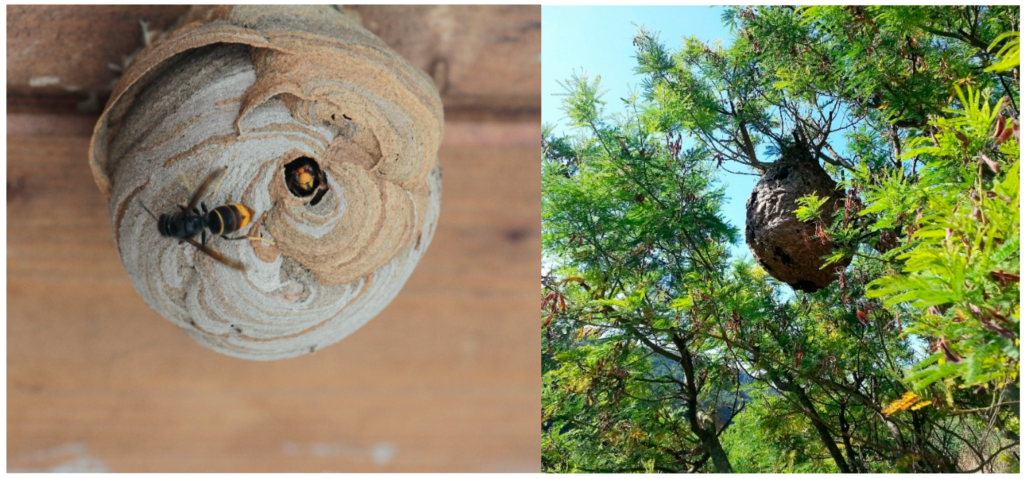
Threat to Bee Populations
Unlike many other predators, Asian hornets don’t just hunt bees opportunistically; they actively target honey bee colonies and apiaries, making them a formidable threat to beekeepers and agricultural ecosystems.
Asian hornets are known to settle down near honey bee colonies or apiaries and establish hunting territories above these locations. They specialize in preying on honey bees, particularly the western honey bee (Apis mellifera), which has not evolved effective strategies to counter the concentrated hawking tactics employed by Asian hornets. In their native range, Asian hornets primarily target the eastern honey bee (Apis cerana), which has developed defensive strategies such as rapid entry and exit from the hive when hornets are present, as well as effective balling techniques by guard bees to kill hornets.
Strategic Hunting
The hunting behavior of Asian hornets is strategic and relentless. Each hornet occupies a specific hunting territory and vigorously defends it against rivals. They scan the direction from which foraging honey bees return to the hive, targeting individual bees in mid-flight. When a hornet catches a bee, it quickly flies off, allowing another hornet to take its place within seconds. This constant cycling of hunting hornets ensures a continuous threat to bee colonies throughout the day, with peak activity observed in the morning and afternoon.
Apis mellifera approach their hives more indirectly and slowly, making them easier targets for hawking hornets. While both Apis cerana and Apis mellifera engage in balling behavior to defend against hornets, the effectiveness of this defense mechanism is higher in Apis cerana due to their ability to achieve higher temperatures in the ball attack. Additionally, Apis cerana guard bees use wing shimmering and endothermic heat production as defensive strategies, which are not observed in Apis mellifera.
Impact on Beekeeping and Agriculture
As an invasive species, Asian hornets have spread rapidly, particularly in regions such as Europe and parts of Asia, causing detrimental effects on bee populations and posing risks to human health.
Spread of Asian Hornets in Europe
The presence of Asian hornets was first noted in France, Spain, Portugal, and other European countries, marking the beginning of their invasive journey in the region. The introduction of the species to France in 2004, believed to have arrived in boxes of pottery from China, initiated a cascade of rapid expansion.
By 2009, thousands of nests were reported in Bordeaux and surrounding areas, highlighting the rapid proliferation of these predatory insects. Over the years, Asian hornets have spread across France, with numerous sightings and nests reported throughout the country, leading to significant concerns among beekeepers and agricultural experts.
The spread of Asian hornets extended beyond France, reaching northern Spain, Portugal, Belgium, Italy, Germany, the Netherlands, Luxembourg, and even the United Kingdom. The discovery of Asian hornet nests and colonies in these countries underscored the invasive nature of these predators and the challenges they pose to local bee populations and ecosystems.
Impact on Human Health and Safety
While the primary impact of Asian hornets is on bee populations and beekeeping activities, there are also concerns regarding human health and safety. Asian hornets, although not inherently aggressive, can exhibit defensive behaviors when their nests are threatened. This can lead to attacks on humans, resulting in stings that can be more serious than those from western honey bees. In cases of multiple stings or allergic reactions, individuals may experience anaphylactic shock, requiring medical attention and hospitalization.
Tragic incidents, such as the death of a man in Galicia, Spain, after being stung over 20 times while pruning an apple tree, highlight the potential dangers posed by Asian hornets to human life. Similar reports of fatalities and hospitalizations due to Asian hornet stings have been documented in France and other affected regions, raising awareness about the need for caution and preventive measures when dealing with these invasive insects.
Management and Control Strategies
Asian hornets exhibit specific behaviors that can be observed to identify their presence and take necessary action. Foraging Asian hornets are most active during the day, particularly from spring until autumn, depending on the climate. They cease their activity at dusk, making daylight hours optimal for monitoring their movements.
One key behavior of Asian hornets is their “hawking” technique outside honeybee colonies. They hover near hive entrances, targeting foraging bees returning with pollen or nectar. Asian hornets swiftly incapacitate bees, forcing them to drop to the ground before paralyzing them. The hornets then decapitate the bees, remove their legs and wings, and transport the bodies to their nests. This predatory behavior can significantly impact honeybee populations if left unchecked.
Additionally, there are reports of Asian hornets entering honeybee colonies to steal brood and honey. They attack guard bees and rob the brood nest, further stressing bee colonies and leading to potential hive losses. In their native regions, Asian hornets have been known to destroy up to 30% of Asian honeybee colonies, with complete hive losses observed in areas with high hornet densities.
Asian hornets also pose a threat to native biodiversity by preying on other social wasp and insect species, as well as consuming various invertebrates like crickets, butterflies, flies, caterpillars, and spiders. They may also feed on ripe fruit and flowers, impacting ecosystem dynamics.
How To Protect The Beehives
To manage Asian hornet populations and protect bee colonies, beekeepers and authorities utilize several control strategies:
Nest Detection: Asian hornet nests are typically found high in trees or hidden in structures like garages, sheds, or holes. In autumn, nests become more visible as they reach their largest size. Inspecting areas close to bee hives for nest presence is essential.
Traps: Commercially available traps can be strategically placed around hives to capture foraging hornets and reduce their numbers. Home-made traps can also be effective with proper design and placement.
Biocontrol: Biocontrol methods using natural predators or parasites of Asian hornets have been explored. The purple pitcher plant (Sarracenia purpurea) was investigated as a potential biocontrol due to its ability to trap hornets, but its unselective nature led to reconsideration of its use. The parasitic fly Conops vesicularis has shown promise in infecting Asian hornet queens, disrupting their ability to establish colonies.
Public Awareness: Educating beekeepers and the public about Asian hornet identification, behaviors, and reporting protocols is crucial for early detection and swift action.


